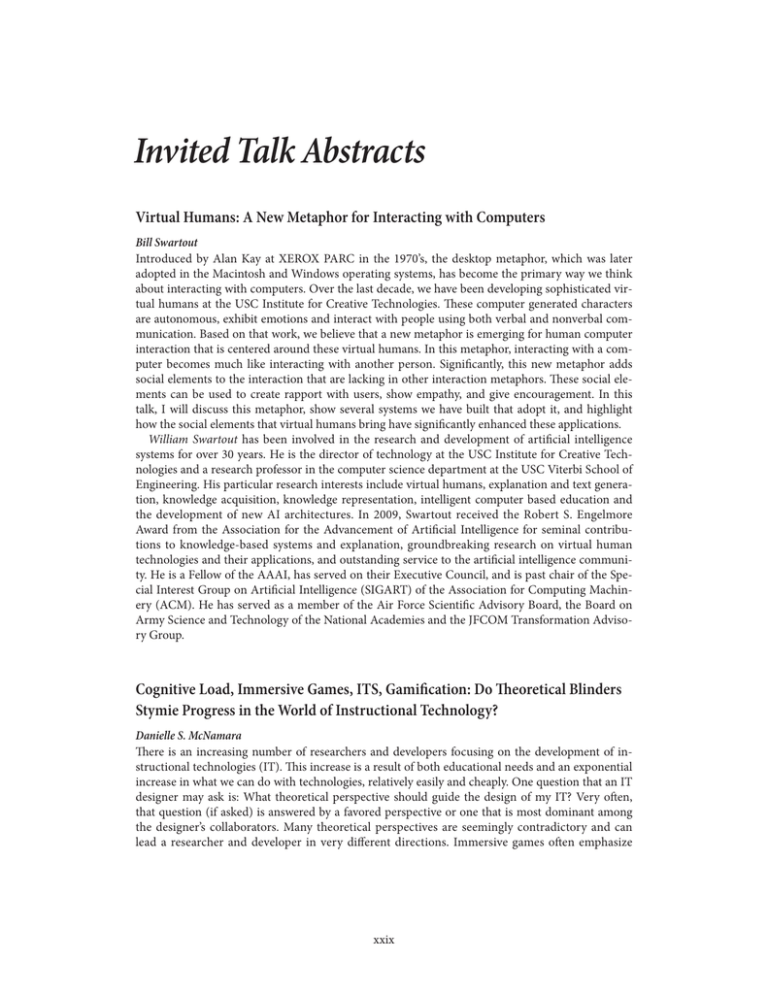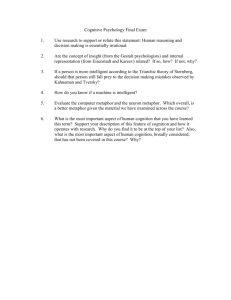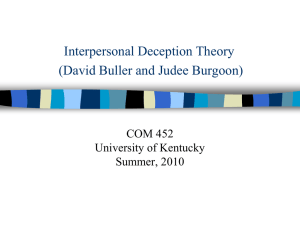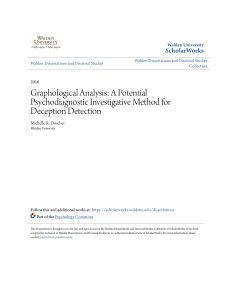Invited Talk Abstracts
advertisement

Invited Talk Abstracts Virtual Humans: A New Metaphor for Interacting with Computers Bill Swartout Introduced by Alan Kay at XEROX PARC in the 1970’s, the desktop metaphor, which was later adopted in the Macintosh and Windows operating systems, has become the primary way we think about interacting with computers. Over the last decade, we have been developing sophisticated virtual humans at the USC Institute for Creative Technologies. ese computer generated characters are autonomous, exhibit emotions and interact with people using both verbal and nonverbal communication. Based on that work, we believe that a new metaphor is emerging for human computer interaction that is centered around these virtual humans. In this metaphor, interacting with a computer becomes much like interacting with another person. Significantly, this new metaphor adds social elements to the interaction that are lacking in other interaction metaphors. ese social elements can be used to create rapport with users, show empathy, and give encouragement. In this talk, I will discuss this metaphor, show several systems we have built that adopt it, and highlight how the social elements that virtual humans bring have significantly enhanced these applications. William Swartout has been involved in the research and development of artificial intelligence systems for over 30 years. He is the director of technology at the USC Institute for Creative Technologies and a research professor in the computer science department at the USC Viterbi School of Engineering. His particular research interests include virtual humans, explanation and text generation, knowledge acquisition, knowledge representation, intelligent computer based education and the development of new AI architectures. In 2009, Swartout received the Robert S. Engelmore Award from the Association for the Advancement of Artificial Intelligence for seminal contributions to knowledge-based systems and explanation, groundbreaking research on virtual human technologies and their applications, and outstanding service to the artificial intelligence community. He is a Fellow of the AAAI, has served on their Executive Council, and is past chair of the Special Interest Group on Artificial Intelligence (SIGART) of the Association for Computing Machinery (ACM). He has served as a member of the Air Force Scientific Advisory Board, the Board on Army Science and Technology of the National Academies and the JFCOM Transformation Advisory Group. Cognitive Load, Immersive Games, ITS, Gamification: Do eoretical Blinders Stymie Progress in the World of Instructional Technology? Danielle S. McNamara ere is an increasing number of researchers and developers focusing on the development of instructional technologies (IT). is increase is a result of both educational needs and an exponential increase in what we can do with technologies, relatively easily and cheaply. One question that an IT designer may ask is: What theoretical perspective should guide the design of my IT? Very oen, that question (if asked) is answered by a favored perspective or one that is most dominant among the designer’s collaborators. Many theoretical perspectives are seemingly contradictory and can lead a researcher and developer in very different directions. Immersive games oen emphasize xxix transformational learning and complete immersion in an alternative world, rarely if ever following cognitive load principles. Indeed, immersion in an alternative environment seems to require cognitive load. Intelligent tutoring systems follow principles aligned with skill and knowledge acquisition, but oen ignore motivation and emotion during learning. Designers of dynamic mini-games may follow principles associated with gamification, ignoring principles associated with transformational and immersive learning. ese camps oen operate with disregard to alternative theories. Most importantly, sometimes there is a lack of alignment between the approach and the targeted learning objective. I will discuss these theoretical principles and their advantages and limitations, providing both examples and counter examples. I argue that researchers developing educational technologies, including educational games, should consider a variety of principles but also the alignment between the design principles and the targeted learning objectives in the particular IT. Oen, however, it seems that researchers and designers adopt one approach or theoretical principal over another, with blinders to alternatives. Is this an optimal approach to designing educational technologies or does this stymie our progress in designing effective technologies for education? Danielle S. McNamara (Ph.D. 1992, University of Colorado, Boulder) joined the Arizona State University Learning Sciences Institute, Department of Psychology, and the School of CIDSE in the fall of 2011. She joined Arizona State University from the University of Memphis where she was director of the Institute for Intelligent Systems and a professor in the Department of Psychology for 9 years. Her academic background includes a linguistics B.A. (1982), a clinical psychology M.S. (1989), and a Ph.D. in cognitive psychology (1992; University of Colorado, Boulder). e overarching theme of her research is to better understand cognitive processes involved in comprehension, writing, knowledge acquisition, and memory, and to apply that understanding to educational practice by developing and testing educational technologies (such as Coh-Metrix, iSTART, and Writing Pal). Two of her projects, e Writing Pal and iSTART, are computer assisted learning programs designed to advance students writing and reading comprehension. Coh-Metrix is a text analysis tool designed to advance our understanding of the nature of text difficulty. McNamara has published over 200 papers and secured over 10 million in federal funding. Her work has been funded by the Institute of Education Sciences (IES), the National Science Foundation (NSF), the McDonnell Foundation, and the Gates Foundation. She serves as associate editor for topiCS, the Cognitive Science Journal, and the Journal of Educational Psychology and currently serves on a standing review panel for the National Institute of Health (NIH) as well as numerous review panels for IES, NSF, and NICHD. She has served on the governing boards for the Society for Text and Discourse and the Cognitive Science Society. Exploring the Deep: Inference-Based Robotic Exploration of the Coastal Ocean Kanna Rajan Persistent undersampling of complex coastal ocean processes has resulted in calls for new methods to approach the sampling problem. Autonomous underwater vehicles (AUVs) have been used over the last few years to observe dynamic events such as blooms, anoxic zones and ocean fronts. However they have until recently, been stymied with the use of simple reactive approaches, which depended on a priori plans that prevented any substantiative adaptation of mission structure to deal with opportunistic science and other unanticipated events. We motivate the use of artificial intelligence based planning/execution using generative planning techniques in-situ for such robots and highlight the range and diversity of applications which have been impacted to enable novel obser- xxx vations. is talk will explore collaborative scientific missions used within a very interdisciplinary environment at MBARI and highlight future challenges for this domain in planning, data mining, mixed-initiative distributed control, and machine learning. Kanna Rajan is the principal researcher in autonomy at the Monterey Bay Aquarium Research Institute (a privately funded nonprofit oceanographic institute funded by the Packard Foundation), which he joined in October 2005. Prior to that he was a senior research scientist for the autonomous systems and robotics area at NASA Ames Research Center, Moffett Field, California. At NASA he was deeply involved in the flight of the Remote Agent Experiment (first closed-loop AI controller in space and first automated planner in space) and the PI of the MAPGEN command and control system for the twin Mars rovers for the MER mission. At MBARI he heads the only AI group in an operational oceanography setting anywhere. Besides other NASA awards, he is the recipient of two NASA medals; a public service medal for his role in the remote agent and the exceptional service medal for the Mars Exploration Rovers mission. His primary academic interests are in planning, plan execution and agent architectures for robotic platforms. Special Track Invited Speaker Abstracts Educational Data Mining, Bayesian Networks and ASSISTments Neil T. Heffernan III Intelligent Tutoring Systems Track Invited Speaker Educational data mining is concerned with a variety of topics, including modeling student learning. is field has taken off in this decade spurring the creation of a new conference and journal. I will talk about work modeling the learning process with Bayesian networks. is work is joint work with my graduating doctoral student, Zach Pardos. Pardos has investigated new types of questions like “What question and content cause the most learning?” and “What is the right way to sequence content?” and “What are the best ways to predict student performance? and “What are good ways to individualize models to take into account difference in students?” I will also talk about the methodological questions about what are the best ways to fit such models and in what cases are fitting procedures like expectation maximization likely to be reliable. I will also say a few words about the KDD Cup Challenge, in which Pardos was awarded a prize in 2010. I will conclude with some thoughts about how this work, and work like it is likely to have impact across the nation. Neil Heffernan graduated summa cum laude from Amherst College in History and Computer Science. As part of Teach for America, Heffernan taught mathematics to eighth grade students in Baltimore City. He then decided to do something easier and get a PhD in computer science, enrolling in Carnegie Mellon University’s Computer Science Department to do multidisciplinary research in cognitive science and computer science to create educational soware that leads to higher student achievement. ere he built the first intelligent tutoring system that incorporated a model of tutorial dialog. is technology was patented and licensed to Carnegie Learning Inc. Currently, Heffernan is an associate professor at Worcester Polytechnic Institute, where he focuses on creating cognitive models, computer simulations of student thinking and learning used to design educational technologies. At the heart of his work is the development and use of ASSISTments, a tool that turns educational research into effective educational practice. Heffernan works with teachers and WPI graduate students to create the next generation of intelligent tutoring systems that are currently being used by over 10,000 students nationwide. xxxi e Devil Is in the Details: New Directions in Deception Analysis Philip McCarthy Applied Natural Language Processing Track Invited Speaker In this study, I use the computational textual analysis tool, the Gramulator, to identify and examine the distinctive linguistic features of deceptive and truthful discourse. e theme of the study is abortion rights and the deceptive texts are derived from a Devil’s Advocate approach, conducted to suppress personal beliefs and values. Our study takes the form of a contrastive corpus analysis, and produces systematic differences between truthful and deceptive personal accounts. Results suggest that deceivers employ a distancing strategy that is oen associated with deceptive linguistic behavior. Ultimately, these deceivers struggle to adopt a truth perspective. Perhaps of most importance, our results indicate issues of concern with current deception detection theory and methodology. From a theoretical standpoint, our results question whether deceivers are deceiving at all or whether they are merely poorly expressing a rhetorical position, caused by being forced to speculate on a perceived proto-typical position. From a methodological standpoint, our results cause us to question the validity of deception corpora. Consequently, I propose new rigorous standards so as to better understand the subject matter of the deception field. Finally, I question the prevailing approach of abstract data measurement and call for future assessment to consider contextual lexical features. I conclude by suggesting a prudent approach to future research for fear that our eagerness to analyze and theorize may cause us to misidentify deception. Aer all, successful deception, which is the kind we seek to detect, is likely to be an elusive and fickle prey. Philip M. McCarthy (Ph.D. 2005) is a discourse scientist working in applied natural language processing (ANLP) at e University of Memphis, Tennessee. He is also director of linguistics for Decooda Marketing Insights where he is responsible for the branch of research and development on textual analytics. His background includes a philosophy B.A. (honors) in 1991 from the University of Greenwich, London, UK, and a Master’s and Ph.D. in linguistics from e University of Memphis. His post doctoral work was conducted at the Institute for Intelligent Systems. He is the coeditor of the two introductory volumes on ANLP: Applied Natural Language Processing: Identification, Investigation and Resolution; and Cross-Disciplinary Advances in Applied Natural Language Processing. e goal of his research is to produce computational tools and investigative approaches that facilitate natural language understanding and assessment. To this end, he has produced numerous measures (such as MTLD and MED, which originally appeared in the Coh-Metrix system) and also full blown systems such as the Gramulator. His particular areas of specialty include lexical diversity, deception, sentiment analysis, contrastive corpus analysis, and machine differential diagnostics. He has over 50 publications and has helped to secure over $2 million in federal funding. xxxii





